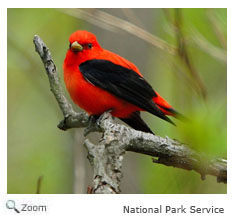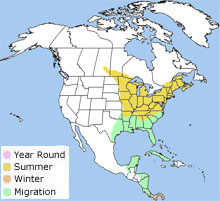Description
 The scarlet tanager is around 6.25 inches in length. It has a stout, pointed bill. During the breeding season, the male scarlet tanager is bright red with black wings and a black tail. In the non-breeding season, the male is a bright olive-green with black wings and a black tail. The female has an olive green back, brownish-gray wings,
yellow underparts, and a brownish-gray tail edged in green. The scarlet tanager is around 6.25 inches in length. It has a stout, pointed bill. During the breeding season, the male scarlet tanager is bright red with black wings and a black tail. In the non-breeding season, the male is a bright olive-green with black wings and a black tail. The female has an olive green back, brownish-gray wings,
yellow underparts, and a brownish-gray tail edged in green.
Range  The scarlet tanager breeds in eastern
North America. In the winter, it is found in montane evergreen forests on the eastern side of the Andes Mountains in South America. The scarlet tanager breeds in eastern
North America. In the winter, it is found in montane evergreen forests on the eastern side of the Andes Mountains in South America.
HabitatThe scarlet tanager breeds in deciduous and mixed deciduous/coniferous woodlands and forests. They may also be found in heavily wooded suburban areas. |
|
Diet
 The scarlet tanager eats insects and spiders. It also eats some fruit.
It gleans insects from trees and sometimes from the ground. It also catches insects while in flight. It often beats the insects it catches against a tree branch to kill them. The scarlet tanager eats insects and spiders. It also eats some fruit.
It gleans insects from trees and sometimes from the ground. It also catches insects while in flight. It often beats the insects it catches against a tree branch to kill them. Life Cycle
 In the spring, male scarlet tanagers establish breeding territories in tall trees before the females return. The scarlet tanager male will warns off other males with vocalizations. He attracts a mate with vocalizations and by flying to a branch below the female and spreading his wings and stretching out his neck to show off his bright scarlet back. The female scarlet tanager lays 3-5 pale blue eggs with brown speckles in a shallow, cup-shaped nest made of twigs, grass, and bark and lined with grass and pine needles. The nest is usually placed about 20-30 feet above the ground on a horizontal branch of a tree, halfway between the tree trunk and the end of the branch. The nest is almost always built in a cluster of leaves. The eggs hatch in 13-14 days. The female incubates the eggs and broods the chicks. Both the female and the male bring the chicks food. The chicks fledge in 9-11 days. In the spring, male scarlet tanagers establish breeding territories in tall trees before the females return. The scarlet tanager male will warns off other males with vocalizations. He attracts a mate with vocalizations and by flying to a branch below the female and spreading his wings and stretching out his neck to show off his bright scarlet back. The female scarlet tanager lays 3-5 pale blue eggs with brown speckles in a shallow, cup-shaped nest made of twigs, grass, and bark and lined with grass and pine needles. The nest is usually placed about 20-30 feet above the ground on a horizontal branch of a tree, halfway between the tree trunk and the end of the branch. The nest is almost always built in a cluster of leaves. The eggs hatch in 13-14 days. The female incubates the eggs and broods the chicks. Both the female and the male bring the chicks food. The chicks fledge in 9-11 days.
Behavior
Despite the male scarlet tanager's bright-red color, it is not easy to spot a scarlet tanager because they spend most of their time high in the forest canopy.
|


 The scarlet tanager breeds in eastern
North America. In the winter, it is found in montane evergreen forests on the eastern side of the Andes Mountains in South America.
The scarlet tanager breeds in eastern
North America. In the winter, it is found in montane evergreen forests on the eastern side of the Andes Mountains in South America.

